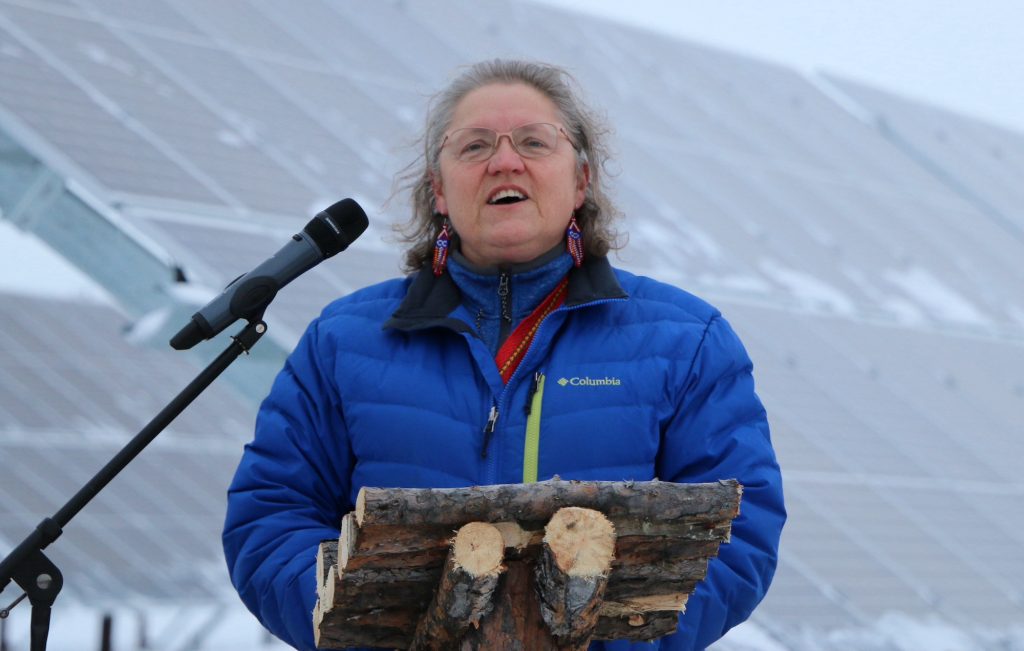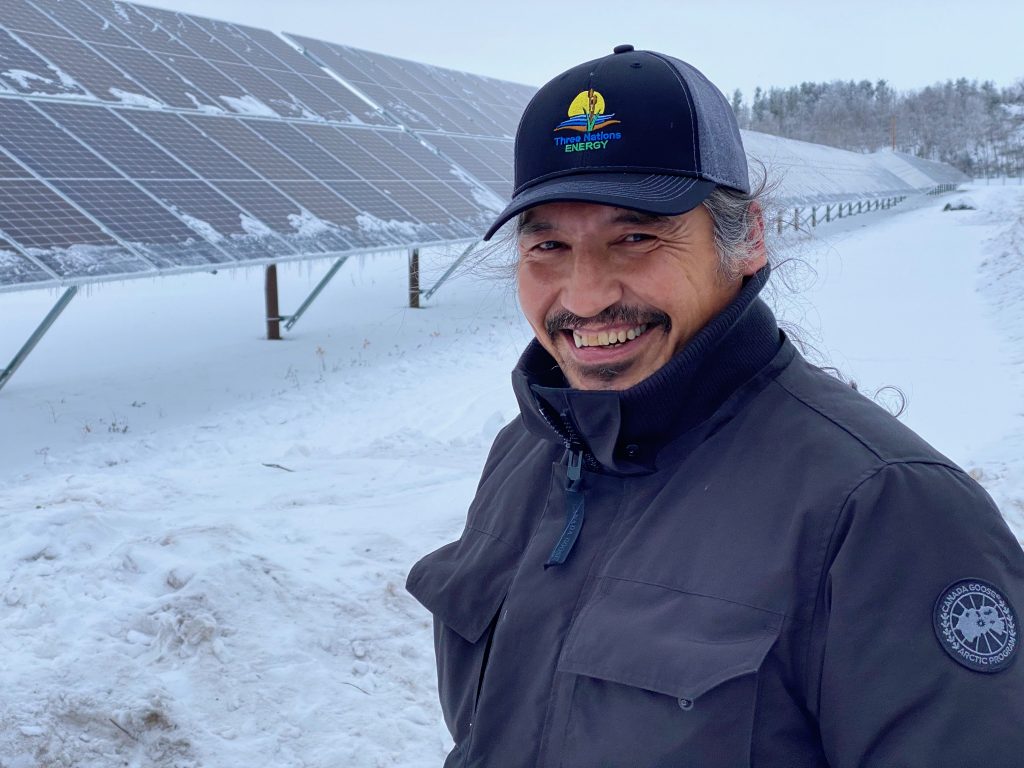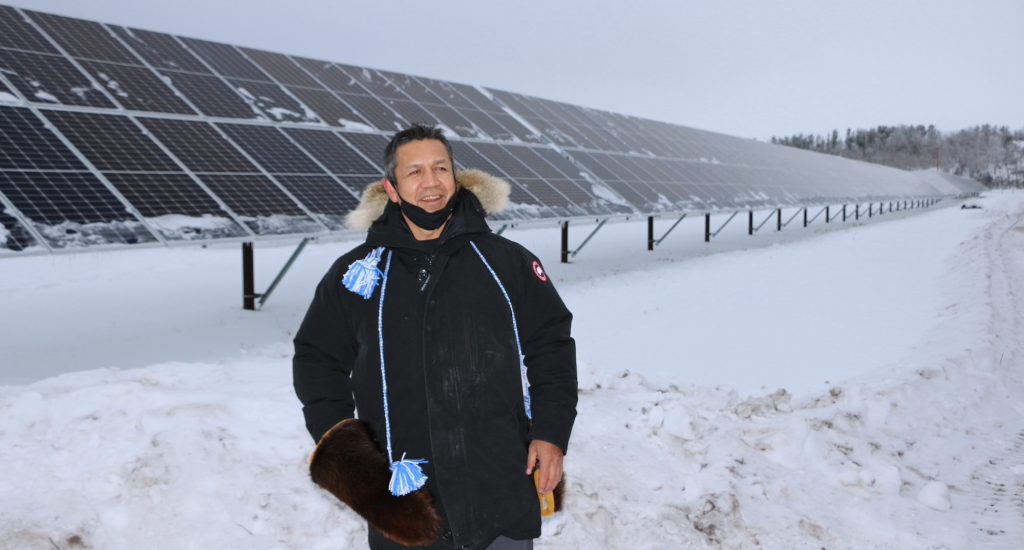By David Dodge and Kay Rollans
In an amazing project, three Indigenous Nations in northern Canada joined forces to build a 2.2-megawatt solar project to replace 25 per cent of the local diesel-generated electricity. What’s more, it’s completely community-owned.
Fort Chipewyan, a town in Northern Alberta, is well beyond the end of Alberta’s electricity grid. Historically, ATCO has operated a microgrid that used 100 per cent diesel-generated electricity.
Now, the local First Nations have worked with ATCO and the federal and provincial governments to create a new vision for low-carbon solar electricity. Together, they have built two solar projects to reduce the amount of diesel electricity used by the community.
A portrait of Fort Chip
To get to Fort Chipewyan, you drive nearly to the end of the road and fly in a small plane from Fort McMurray, Alberta over the largest oilsands operations in the world, The flight also takes you over the mighty Peace-Athabasca Delta: the largest inland river delta in North America and one of the last places on Earth, along with nearby Wood Buffalo National Park with wild native bison and endangered whooping cranes.
Fort Chipewyan is an Indigenous community of about 1,000 people, most of whom are from the Athabasca Chipewyan First Nation (AFCN), the Mikisew Cree First Nation (MCFN), or the Fort Chipewyan Métis.
The Athabasca Chipewyan are Dene people; they and the Mikisew Cree fought over these lands many years ago. Today, they coexist in a beautiful community that is located on the shores of Lake Athabasca, an 8,000 km2 giant of a lake that spans two provinces in northern Canada.
All in all, it feels more like a coastal fishing village than a northern boreal community.

“We’re just a small community in northeastern Alberta, isolated, you know, and…this is such a rich community,” says Blue Eyes Simpson from the Fort Chipewyan Métis Association and director of community-owned Three Nations Energy (3NE). “And we’ve always depended on the ATCO energy source.”
ATCO continues to provide the community with electricity—but the community now has a share of the local electricity production business.

The story of three Nations and two solar farms
In 2019, ATCO completed a 600-kilowatt solar farm. It was the first step toward replacing 25 per cent of the diesel-generated electricity in Fort Chipewyan with good, old-fashioned sunlight.
“Well, after so many years of speaking about, the environment and clean energy and stuff like that, we thought that we would lead by example and start doing what we were preaching,” says Chief Allan Adam of the ACFN.
On November 17, 2020, 3NE launched its own, community-owned, 2.2-megawatt solar farm project.
“We’re all working together. And that’s a really good feeling in our community. And this, you know, energy is one of the things that are very important to us. We’ve always relied on fossil fuel, but we’re switching over to renewable energy,” says Chief Peter Powder at the solar launch event in Fort Chipewyan.

Green Energy Futures went for a tour of the solar farm, which sits close to the airport, adjacent to the diesel generating station owned by ATCO.
“Behind me you have a 2.2-megawatt solar farm owned and operated by Three Nations Energy, which has even ownership from Athabasca Chipewyan First Nation, the Metis Local here and Mikisew First Nation,” says Calvin Waquan, former Mikisew Cree Councillor and former director of 3NE.
ATCO has also been a steadfast partner on the project from the outset. Not only does it own the 600-kilowatt solar project that kicked off Fort Chipewyan’s shift to solar, but it has served as general contractor for the 3NE solar project this year.
“This project demonstrates your commitment to be leaders in environmental stewardship and is an important step in reducing reliance on diesel fuel in remote communities like this and across the province and across Canada,” said Melanie Bayley a senior VP from ATCO at the launch event.
ATCO is the grid owner and operator in Fort Chipewyan. This remote microgrid is completely independent of the Alberta Electricity grid.
As for the three Nations of 3NE, they have never partnered on a business venture before. At first, there were a few bumps in the road; after all, getting three separate governments on the same page is hard work. “We squabbled a bit at the start,” Chief Adam says, but “now all we’re looking at are the benefits of everything that is here.”
The solar farm has certainly caught the attention of locals. According to 3NE director Simpson, people flying in and out of Fort Chipewyan kept talking about the “big glass windows” on the ground. For Simpson, this was a great opportunity to explain to the community how solar modules harvest energy from the sun.
Diesel woes and winter roads
ATCO’s senior VP of development Paul Goguen says it’s important to minimize the use of diesel fuel in these remote communities, both to reduce emissions and to reduce the risk of trucking fuel over winter roads that are increasingly vulnerable to the effects of climate change. For much of the year, the only way into Fort Chip is by air or boat.
Chief Adam agrees: “It’s getting harder for us to bring the fuel into the community because of the winter roads. So the community is at risk. And if the community is at risk, then we as leaders are not taking care of the community.”
Chief Powder agrees “I think the main thing is, is, is diesel fuel, less diesel fuel down the highway.”
The solar projects will replace 25 per cent of Fort Chipewyan’s diesel-generated electricity, reducing emissions, saving 800,000 litres of diesel fuel per year, and reducing the number of tanker trucks that must traverse the winter ice road by 25 trips annually.
What’s more, due to good project management they saved some money are getting more solar because of it.
“During procurement, we saved quite a bit of dollars thanks to our project managers Clayton [Stafford] and Rob [MacIntosh] and the great team that they have. We managed to save and purchase that extra row [of solar],” says Waquan.
Stafford and MacIntosh are with Greenplanet Energy Analytics, the group 3NE hired to manage the project. The savings they found will add almost 350 solar panels to the project.
“By the end of it, it’s going to be about 2.35 megawatts with one 1.5 megawatts of battery storage with our partners ATCO,” says Waquan.
Community ownership an asset for green energy
Community ownership is a value lost to many participating in the clean energy revolution, but not on these First Nations. For the three Nations that own this solar project, it means revenue for the Nations themselves, job training in new technologies for Nation members, and jobs as well.
“This is a project that’s very successful,” says Chief Adam. “Everybody benefited from it. That was the beauty of it. And that’s the beauty of working together,” he says.
“It’s become very big and very close to our heart and very exciting because it is something that’s moving us forward as technology does every day,” says Simpson.
But the solar farm isn’t the only innovative project on 3NE’s plate. The nations are working again with Greenplanet Energy Analytics on creating new businesses and food security.
They have also purchased a wood processing machine to split the wood cleared from the solar farm site to produce local fuel. There is ample supply of wood beyond the salvage and, with Fire Smart operations ongoing, they are starting a new wood fuel business, employing local folks and creating a local supply of wood.
“I just like green energy because I love the planet so much and, you know, I was raised in an environment where it was clean, where I drank the water from the lake as a young kid, I swam in lake Athabasca, and we hunt fish here and everything,” says Chief Adam. “I just want things to slowly at least turn back the clock and hopefully we will be able to correct some of the problems that are out there.”
The 3NE’s solar and other projects have instilled a sense of pride and optimism for the future in local folks of this remote Indigenous community in northern Canada.
As for the potential to do more projects and build a more sustainable, resilient community Calvin Waquan sums it up nicely: “I think the sky’s the limit. You know, I always shoot for the stars and if you fall short, you’re still soaring with the Eagles.”


